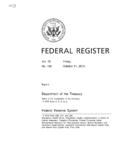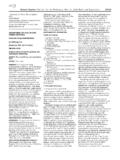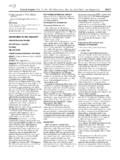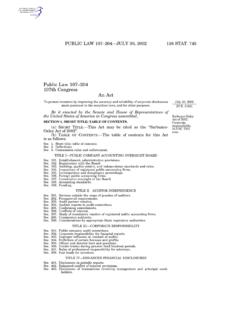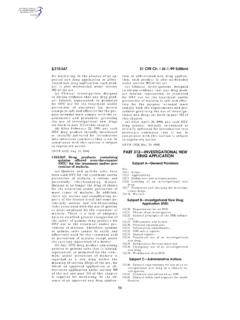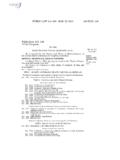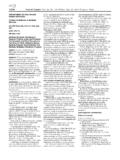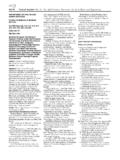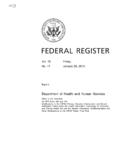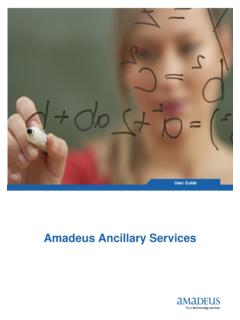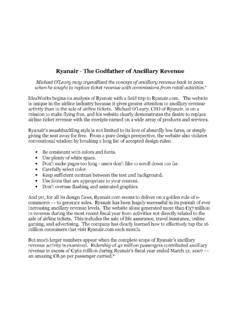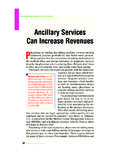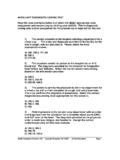Transcription of 29182 Federal Register /Vol. 82, No. 122/Tuesday, June 27 ...
1 29182 Federal Register / Vol. 82, No. 122 / tuesday , june 27, 2017 / proposed Rules DEPARTMENT OF LABOR Occupational Safety and Health Administration 29 CFR Parts 1915 and 1926 [Docket No. OSHA H005C 2006 0870] RIN 1218 AB76 Occupational Exposure to Beryllium and Beryllium Compounds in Construction and Shipyard Sectors AGENCY: Occupational Safety and Health Administration (OSHA), Department of Labor. ACTION: proposed rule; request for comments. SUMMARY: The Occupational Safety and Health Administration (OSHA) proposes to revoke the ancillary provisions for the construction and the shipyard sectors that OSHA adopted on January 9, 2017 but retain the new lower permissible exposure limit (PEL) of mg/m3and the short term exposure limit (STEL) of mg/m3for each sector. OSHA will not enforce the January 9, 2017 shipyard and construction standards without further notice while this new rulemaking is underway.
2 This proposal does not affect the general industry beryllium standard published on January 9, 2017 . DATES: Written comments. Written comments, including comments on the information collection determination described in Section VII of the preamble (OMB Review under the Paperwork Reduction Act of 1995), must be submitted (postmarked, sent, or received) by August 28, 2017 . Informal public hearings. The Agency will schedule an informal public hearing on the proposed rule if requested during the comment period. The location and date of the hearing, procedures for interested parties to notify the Agency of their intention to participate, and procedures for participants to submit their testimony and documentary evidence will be announced in the Federal Register if a hearing is requested. ADDRESSES: Written comments. You may submit comments, identified by Docket No.
3 OSHA H005C 2006 0870, by any of the following methods: Electronically: You may submit comments and attachments electronically at , which is the Federal e-Rulemaking Portal. Follow the instructions on-line for making electronic submissions. When uploading multiple attachments into , please number all of your attachments because will not automatically number the attachments. This will be very useful in identifying all attachments in the beryllium rule. For example, Attachment 1 title of your document, Attachment 2 title of your document, Attachment 3 title of your document, etc. Specific instructions for uploading documents are found in the Frequently Asked Questions portion and the commenter check list on Fax: If your submissions, including attachments, are not longer than 10 pages, you may fax them to the OSHA Docket Office at (202) 693 1648.
4 Mail, hand delivery, express mail, messenger, or courier service: You may submit your comments to the OSHA Docket Office, Docket No. OSHA H005C 2006 0870, Room N 3653, Department of Labor, 200 Constitution Avenue NW., Washington, DC 20210, telephone (202) 693 2350 (OSHA s TTY number is (877) 889 5627). OSHA s Docket Office accepts deliveries (hand deliveries, express mail, and messenger/ courier service) from 10 to 3 , weekdays. Instructions: All submissions must include the Agency name and the docket number for this rulemaking (Docket No. OSHA H005C 2006 0870). All comments, including any personal information you provide, are placed in the public docket without change and may be made available online at http:// Therefore, OSHA cautions you about submitting personal information such as Social Security numbers and birthdates. Docket: To read or download comments and materials submitted in response to this Federal Register notice, go to Docket No.
5 OSHA H005C 2006 0870 at , or to the OSHA Docket Office at the address above. All comments and submissions are listed in the index; however, some information ( , copyrighted material) is not publicly available to read or download through that Web site. All comments and submissions are available for inspection at the OSHA Docket Office. Electronic copies of this Federal Register document are available at Copies also are available from the OSHA Office of Publications, Room N 3101, Department of Labor, 200 Constitution Avenue NW., Washington, DC 20210; telephone (202) 693 1888. This document, as well as news releases and other relevant information, is also available at OSHA s Web site at http:// FOR FURTHER INFORMATION CONTACT: For general information and press inquiries, contact Frank Meilinger, Director, Office of Communications, Room N 3647, OSHA, Department of Labor, 200 Constitution Avenue NW.
6 , Washington, DC 20210; telephone: (202) 693 1999; email: For technical inquiries, contact: William Perry or Maureen Ruskin, Directorate of Standards and Guidance, Room N 3718, OSHA, Department of Labor, 200 Constitution Avenue NW., Washington, DC 20210; telephone (202) 693 1955 or fax (202) 693 1678; email: SUPPLEMENTARY INFORMATION: The preamble to this proposed rule on occupational exposure to beryllium and beryllium compounds follows this outline: I. Executive Summary and Regulatory Issues II. Pertinent Legal Authority III. Events Leading to the Proposal IV. Technological Feasibility Summary V. Preliminary Economic Analysis VI. Economic Feasibility and Regulatory Flexibility Certification VII. OMB Review Under the Paperwork Reduction Act of 1995 VIII. Federalism IX. State-Plan States X. Unfunded Mandates Reform Act XI. Protecting Children From Environmental Health and Safety Risks XII.
7 Environmental Impacts XIII. Consultation and Coordination With Indian Tribal Governments XIV. Public Participation XV. Summary and Explanation of the Proposal Authority and Signature Amendments to Standards I. Executive Summary and Regulatory Issues On January 9, 2017 , OSHA published its final rule Occupational Exposure to Beryllium and Beryllium Compounds in the Federal Register (82 FR 2470). OSHA concluded that employees exposed to beryllium and beryllium compounds at the preceding permissible exposure limits (PELs) were at significant risk of material impairment of health, specifically chronic beryllium disease and lung cancer. OSHA concluded that the new 8-hour time- weighted average (TWA) PEL of mg/ m3reduced this significant risk to the maximum extent feasible. Based on information submitted to the record, in the final rule OSHA issued three separate standards for general industry, for shipyards, and for construction.
8 In addition to the revised PEL, the final rule established a new short-term exposure limit (STEL) of mg/m3over a 15-minute sampling period and an action level of mg/m3as an VerDate Sep<11>2014 19:38 Jun 26, 2017 Jkt 241001 PO 00000 Frm 00002 Fmt 4701 Sfmt 4702 E:\FR\FM\ 27 JNP2mstockstill on DSK30JT082 PROD with PROPOSALS229183 Federal Register / Vol. 82, No. 122 / tuesday , june 27, 2017 / proposed Rules 8-hour TWA, along with a number of ancillary provisions intended to provide additional protections to employees, such as requirements for exposure assessment, methods for controlling exposure, respiratory protection, personal protective clothing and equipment, housekeeping, medical surveillance, hazard communication, and recordkeeping similar to those found in other OSHA health standards. On March 21, 2017 OSHA published a delay of the effective date for the final beryllium rule to May 20, 2017 in the Federal Register (82 FR 14439).
9 This action was based on comments received on OSHA s proposed delay of effective date for the final rule in the Federal Register (82 FR 12318). OSHA proposed this delay in accordance with the January 20, 2017 Presidential directive from the Assistant to the President and Chief of Staff, entitled Regulatory Freeze Pending Review (82 FR 8346 (1/24/17)) that directed agencies to consider further delaying the effective date for regulations beyond the initial 60-day period. After a further review of the comments received on the proposed extension, as well as a review of the applicability of existing OSHA standards, OSHA is proposing to revoke the ancillary provisions applicable to the construction and shipyard sectors, but to retain the new lower PEL of mg/m3and the STEL of mg/m3for those sectors. In the final rule, OSHA reviewed the exposure data for abrasive blasting in construction and shipyards and welding in shipyards and determined that there is a significant risk of chronic beryllium disease (CBD) and lung cancer to workers in construction and shipyards based on the exposure levels observed.
10 Because OSHA determined that there is significant risk of material impairment of health at the new lower PEL of mg/ m3, the Agency continues to believe that it is necessary to protect workers exposed at this level. However, OSHA is now reconsidering the need for ancillary provisions in the construction and shipyards sectors. OSHA has evidence that beryllium exposure in these sectors is limited to the following operations: Abrasive blasting in construction, abrasive blasting in shipyards, and welding in shipyards. OSHA has a number of standards already applicable to these operations, including ventilation (29 CFR ) and mechanical paint removers (29 CFR ). In addition, this proposal provides stakeholders with an additional opportunity to offer comments on the protections needed for workers exposed to beryllium in the construction and shipyard sectors, including the need for the ancillary provisions in the January 9, 2017 construction and shipyard beryllium standards.

